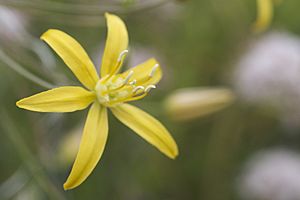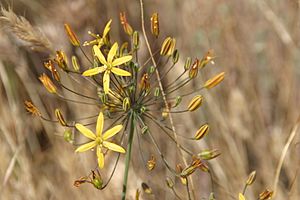Goldenstar facts for kids
Quick facts for kids Goldenstar |
|
|---|---|
 |
|
| Bloomeria crocea near Pomona, California | |
| Scientific classification |

The Bloomeria crocea, also known as goldenstar, is a beautiful wild flower. It grows from a special underground stem called a corm. You can find it in southern California and northern Baja California. This plant loves to grow on hillsides, at the edges of grasslands and chaparral areas, and in dry, flat places.
Contents
What is a Goldenstar Plant Like?
Plant Structure and Flowers
The goldenstar plant grows from a corm, which is like a small, round underground stem. This corm has a tough, stringy outside layer. Usually, each plant grows only one long, thin leaf.
The plant produces bright golden flowers. Each flower has six petals. These flowers grow together in a loose cluster called an umbel, which looks a bit like an umbrella.
How Goldenstars Reproduce
After a goldenstar flower is pollinated, its three-lobed stigma helps create seeds. The plant then forms small seed pods called capsules. These capsules hold tiny black seeds. Once the seeds fall, it takes about three to four years for them to grow into a new, full-grown goldenstar plant. This is a long time for a plant to mature!
Where Do Goldenstars Grow?
Favorite Growing Spots
Bloomeria crocea loves to grow in sunny places. It prefers soil that lets water drain easily and conditions that are semi-dry. You can find these plants in several mountain ranges in California. These include the Peninsular Ranges, Transverse Ranges, and the southern California Coast Ranges. They also grow on the Channel Islands off the coast of California.
Geographic Range
The goldenstar plant is found along the southern coast of California. Its range stretches from Santa Barbara County and western Kern County. From there, it spreads throughout Southern California and goes all the way down into Baja California in Mexico.
Types of Goldenstars
Scientists have identified two main types, or varieties, of Bloomeria crocea:
- B. crocea var. aurea
- B. crocea var. montana
These varieties might have slight differences in their appearance or where they grow.
Images for kids



